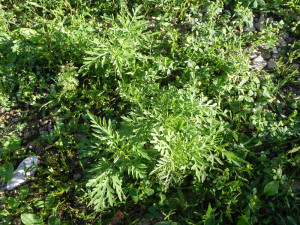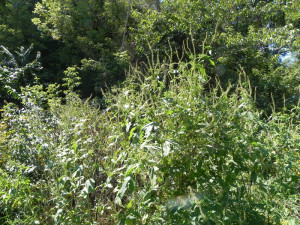Late summer is the dreaded hay fever season! Ragweed is the prime culprit.
Two species of ragweed account for most of the misery. Both are annuals that reseed each year. The seeds only need a bit of bare ground to sprout. They are not fussy, thriving in nearly any type of soil.
True to its name, Common (sometimes called Eastern) Ragweed can be found nearly anywhere people live, especially cities. It can be a prostate plant hugging the ground or sidewalk edge or grow to two or three feet tall on the edge of a yard. Giant (sometimes called Western) Ragweed is less common in suburban and urban areas and can grow to upwards of eight feet tall. It’s abundant on the edge of farm fields where it often forms large thickets. In urban areas Giant Ragweed is most likely found in industrial areas and along railroad tracks. Despite their names either species can be found nearly anywhere in North America, where they are a native plant. Unfortunately ragweed has been introduced to Japan.
Ragweed causes human suffering because in late summer plants produce green flowers that release millions of pollen grains to the wind. Allergic people react after breathing in the tiny grains, which can blow for miles from the parent plant.
Goldenrods are frequently blamed for causing hay fever because of an unfortunate coincidence. They bloom during hay fever season. Goldenrod flowers are a bright yellow, designed to attract pollinating insects. They do not release pollen into the air and are unjustly blamed for causing human misery.
Despite causing hay fever, ragweeds have ecological value. They are a pioneer weed that quickly becomes established on bare soil. Roots hold the soil, preventing erosion. Within a few years ragweeds usually vacate the spot as more stable perennials move it. Ragweed seeds are devoured by many bird species such as quail.
As a general rule any plant that produces unshowey flowers is a wind pollinator that could cause human allergies. This includes many grass and tree species as well as ragweed. In contrast plants that produce colorful showy flowers are normally insect pollinated and don’t cause sneezing.



